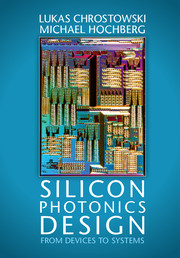1 - Fabless silicon photonics
from Part I - Introduction
Published online by Cambridge University Press: 05 April 2015
Summary
We are on the cusp of revolutionary changes in communication and microsystems technology through the marriage of photonics and electronics on a single platform. By marrying large-scale photonic integration with large-scale electronic integration, wholly new types of systems-on-chip will emerge over the next few years.
Electronic-photonic circuits will play a ubiquitous role globally, impacting such areas as high-speed communications for mobile devices (smartphones, tablets), optical communications within computers and within data centres, sensor systems, and medical applications. In particular, we can expect the earliest impacts to emerge in telecommunications, data centers and high-performance computing, with the technology eventually migrating into higher-volume, shorter-reach consumer applications.
In the emerging field of electronics in the 1970s, Lynn Conway at Xerox PARC and Professor Carver Mead at Caltech developed an electronics design methodology, wrote a textbook, taught students how to design electronic integrated circuits, and had their designs fabricated by Intel and HP as multi-project wafers, where several different designs were shared in a single manufacturing run [1]. These efforts led to the foundation of an organization named MOSIS in 1981 that introduced cost sharing of fabrication runs with public access. The inexpensive design-build-test cycle enabled by MOSIS trained, and continues to train, thousands of designers who are responsible for the ubiquity of electronics we see today. MOSIS got started based on commercial processes that were already in production, and opened them up to the design community for prototyping and research purposes.
One of the keys to the long-term success of the microelectronics community, and in particular of the CMOS community, has been this type of access. By making these volume production processes publicly available for research and development at modest cost, anyone with a very modest level of funding is able to do cutting edge, creative work in a process that can instantly go into large-scale production. Training student engineers to use the production tools and processes, and then letting them loose to build cutting-edge circuits which can, with modest funding, be translated into fabless IC start-ups, has been the source of countless successful companies.
- Type
- Chapter
- Information
- Silicon Photonics DesignFrom Devices to Systems, pp. 3 - 27Publisher: Cambridge University PressPrint publication year: 2015
References
- 3
- Cited by

